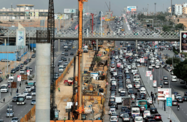Government officials in Egypt have outlined plans to bolster the country’s rail and metro networks, with the construction of new trains to play a large role, alongside system enhancements and line upgrades.

In late January Hesham Arafat, minister of transport, announced that the ministry would tender contracts for the construction of 181 new locomotives and 1300 carriages, including 800 first-class cars, 300 air-conditioned second-class vehicles and 200 for economy class.
Interest from international firms followed; local media reported early last month that 13 companies, including ones from China, Italy, Spain and Romania, were bidding to supply the state’s railway operator with the carriages.
The government expects to award the contracts within the first half of the year, with the requirement that winning bidders source at least 40% of the components they use to build the carriages domestically.
As well as commissioning new trains, Arafat announced that electronic signal and railway system upgrades would be undertaken at a cost of LE16bn ($908.1m) and LE54bn ($3.1bn), respectively.
Cairo metro line upgrades secure funding
Promoting foreign and private investment is seen as crucial to Egypt’s ambitious rail expansion plans. According to ministry statements from March of last year, the government is looking for €14.4bn to fund various rail and metro projects.
With regard to the latter, Egypt expects to secure a total of €600m in funding for the development of the infrastructure for the Cairo Metro Line 1 after it inks a deal this May with the French Development Agency in Cairo, the European Investment Bank, and the European Bank for Reconstruction and Development.
The work proposed on the line aims primarily to increase capacity and introduce high-tech signalling systems, and the National Authority for Tunnels has also pledged €100m to the project.
The upcoming agreement follows a memorandum of understanding between France’s national rail company SNCF and Egyptian Railways in October to provide support for capacity-building risk assessment and development of the railway network.
Within the capital, this bilateral cooperation is focused on the Cairo Metro Line 3, which connects Attaba with Abbasiya and Heliopolis, and will extend from north-west Greater Cairo to the international airport in the north-east.
However, the majority of the €14.4bn in investment being sought is earmarked for a proposed 1200-km, high-speed rail connection linking the capital Cairo with the tourist hotspots of Alexandria, Luxor and Hurghada.
The three-stage, €13bn project is expected to have the capacity to transport 7.2m passengers per year by 2025.
Rail development to boost logistics and trade
However, lines that can carry large volumes of freight and high numbers of commuters may be a more pressing priority in the medium term, particularly given recent fluctuations in tourist arrivals.
At present, railways account for just 2% of freight carried and 8% of domestic passenger traffic, according to Railmed, an organisation that promotes regional rail connectivity.
This has placed significant strain on Egypt’s roads, which suffer from considerable congestion, especially in major cities and commercial areas.
To address the situation, the government aims to boost rail’s share of freight transport to 10% within 10 years through infrastructure improvements and expansions, and hopes to increase the volume of cargo carried on railways from 5m tonnes currently to 25m tonnes by 2020.
Last month local media reported that 45 different consortia and companies had placed bids to construct two proposed projects: a high-speed, electric line from Ain Sokhna on the Gulf of Suez to El Alamein on the Mediterranean, a route that could carry large volumes of freight and bypass the Suez Canal; and a monorail development in western Cairo.
The construction of freight-focused rail links should dovetail other investment in the transport network to improve overall efficiency.
In December the government opened the bidding process for a dry port located outside Cairo, to be undertaken as a public-private partnership. The development – which will have an initial capacity of 360 twenty-foot equivalent units (TEUs) per day, or 130,000 TEUs per year, with the potential to scale up to more than 1.2m TEU – is designed to ease pressure on the Port of Alexandria.
It is the largest of 10 dry port projects due to be rolled out in the near term, and will be connected to the national rail network to transport cargo from Alexandria and the nearby Daqahliyah Port to their final destinations.


